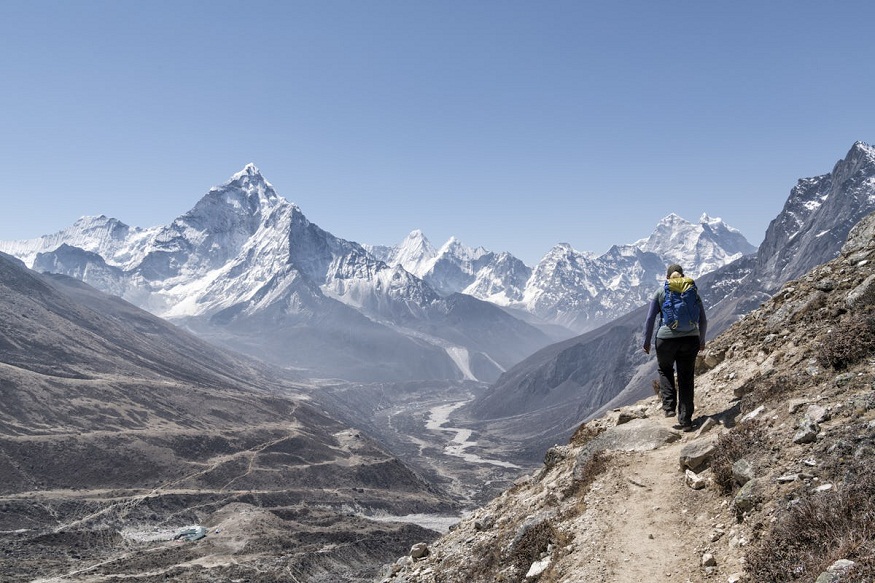The Everest Base Camp trek is one of the classic and exciting adventures that any trekker can do. Incredible views of Mount Everest, dramatic landscapes, and insight into the lives of the Sherpa people make this one of the most beautiful yet challenging treks on this list. But careful planning can help make for a successful and safe trip.
Everest Base Camp Trek Cost: Preparing for the altitude is one of the most important parts of the trek. The elevation of Everest Base Camp is 5,364 meters, which is high enough to cause altitude sickness. Part of avoiding this risk is having acclimatization days. Taking it slow and giving your body time to acclimate will greatly minimize the likelihood of you getting altitude sickness. That is also why many trekkers choose a more gradual itinerary that includes acclimatization days intermixed in Namche Bazaar and Dingboche.
Physical fitness is important for the success of the trek. You don’t have to be an elite athlete, but having a solid base level of fitness will make the trek a lot more enjoyable. You can hack this by training for endurance (long hikes and cardio things) and strength (leg and core work) to get used to long hours of walking and steep inclines. You’ll also need long days of walking, sometimes 6-8 hours or more, so you want stamina.
Packing is another of those tasks that the trekker needs to be thoughtful about. Although wanting to pack everything you may need is natural, overpacking can slow you down and make the hike more difficult. The secret is to travel light but wisely, with clothes that layer, that respond to unpredictable weather. An awesome pair of trekking boots is a key part of wanting to be comfortable and knowing your feet will be put to the test day in and day out. A robust backpack, sleeping bag, and good water bottle system are also your besties on the trail.
Keeping hydrated and eating well also helps keep your energy levels up. Trekking brings with it the risk of dehydration, a fact that’s easy to forget with you’re not necessarily thirsty when you’re at a high altitude. But one of the basic keys to avoiding altitude sickness and maintaining your energy is to stay hydrated. While bringing in regular meals and snacks rich in carbohydrates, proteins, and fats will help your body to have the fuel that you need for the long days ahead. Most trekkers eat local food like dal bhat, a conventional Nepalese meal, on their way up, which gives them the energy needed for the hike.
The weather in the Himalayas is unpredictable, and trekkers must prepare for a fast decline in temperature. Even during the summer months, the temperatures can drop significantly, especially at night. Being prepared for all contingencies, rain and snow, and sun, is key. You can always carry a good rain jacket, thermal wear for high-altitude areas, and warm layers for the evenings.
Lastly, respecting local culture is of utmost importance during trekking in Nepal. The Sherpa are the people whose ways and lives have been found in the region for centuries, with their customs and traditions. Always check permission to photograph people or religious sites, and dress modestly when entering monasteries or homes. Respecting this fact enables one to receive a great experience, same way as having respect for others, leads to actualizing mutual respect.
Everest Base Camp Trek Sufficient preparation is the keyword for making your Everest Base Camp trek as rewarding, memorable, and safe as possible. Whether you hike for the challenge, the view, or the culture, the trek to Base Camp is a deeply spiritual journey connecting you to the world’s highest peak and the resilient people who call it home.
Chapter 1: Table Setting the Right Way
Everest Base Camp (EBC) trek is a pilgrimage of a lifetime with its breathtaking views, amazing culture, and an unmatched challenge. But to successfully tackle this physically demanding expedition, you need to plan and prepare well. Whether you are a long-time trekker or a novice, being prepared can mean the difference between a smooth, pleasurable experience and a painful one. Success is achieved through proper training, smart packing, acclimatization, remaining healthy, and respecting your body. Once you are prepared this way, you will be able to immerse yourself in the trek, admire the stunning landscapes, and arrive at Everest Base Camp without any problems. In the tips that follow, we’ll outline some important steps you should take both before you go and while you’re out on the trail to help set yourself up for success.
Proper Acclimatization to Prevent Altitude Sickness
With high-altitude trekking to Everest Base Camp, altitude sickness is an inherent risk. For preventing altitude sickness, taking it easy and giving your body time to acclimate to the lower amounts of oxygen available is the best strategy. Follow an Itinerary With Rest Days Built In, Particularly After Major Climbs, Such as in Namche Bazaar or Dingboche. You’re working from an itinerary that has planned rest days, but if you’re visiting for more than a real vacation, make sure to pay attention to exactly where those rest days are positioned. These spare days give your industry a chance to adjust to the steeper altitudes, cutting the risk of altitude sickness. Don’t get seduced into powering through symptoms of headaches, nausea, or dizziness — those symptoms are your body telling you that it’s having difficulty adapting. If symptoms don’t go away, going to a lower elevation is important. Staying hydrated and eating often aids acclimatization, and of course, listen to your body if it’s time to rest.
Prepare and Build Your Stamina Before The Trek
Everest Base Camp Treks Make sure you prepare your body for the physical demands of the trek to base camp on Everest. In particular, prioritize aerobic conditioning, such as running, cycling, and hiking with a pack. At least 3-4 months, if not more. Train for walking over varied terrain and uphill, as you’ll be doing both gradual slopes as well as steep inclines. Building up your legs and core will also help with the long days of walking. Hike at a higher altitude (if possible) to simulate altitude conditions, or train with elevation masks. Aside from physical training, make sure you’re comfortable carrying a backpack for long periods to prevent back or shoulder strain on the actual trek. You’ll be well prepared for the long trek to Everest Base Camp if you build your stamina and strength.
Pack Smart and Light
Packing smart for the Everest Base Camp trek is about striking the right balance between being equipped and not overloading. The trick is packing light while ensuring you have everything you need. Go for layers, as temperatures can fluctuate over the day. What to Pack: Moisture-wicking clothing, a warm jacket, durable hiking boots, a decent sleeping bag, and a rain jacket. Remember the sunscreen, a hat, gloves , and a first aid kit. Choose lighter biners because porters will be present to carry most of your luggage, and your backpack is manageable for long journeys. Do not carry many gadgets or items that you do not need. Keep in mind that the lighter the pack you use, the easier your trek will be.
Lakes are not only fun to float in, but they are also serious bodies of water.
The Mount Everest Base Camp Trek route can be very tiring, and it is important to stay hydrated and well fed to keep energy levels up and avoid exhaustion. The dry, high-altitude air will dehydrate you fast, so bring a strong water bottle or hydration system and fill up often on the trail. Sufficient water intake also aids in staving off altitude sickness. The meals during the trek are usually rice, noodles, and soup, which will never be enough to feed a hungry stomach, but there are also some hearty local foods, such as dal bhat, which provides energy. Eat a healthy diet with carbohydrates, protein, and fat. Eat little and often to boost your energy. Stay away from alcohol and too much caffeine, which are dehydrating.” Make sure you eat sufficient calories to keep up with the energy demands of the trek. Hydration and nutrition are key to improving your stamina and overall trekking experience.
Start Slow and Listen to Your Body
Pacing yourself is one of the key tips for a successful trek to Everest Base Camp. It’s essential to go slow and listen to your body, and many trekkers rush to make it to Base Camp. The journey to EBC is long and physically demanding, and if you don’t take your time, you’ll wind up exhausted — and possibly hit with altitude sickness. Spend time acclimatizing to altitude and make sure you’re well-rested before advancing to the next stage. If you sharpen slow and steady progress, there you have the recipe for a safe and enjoyable trek. When feeling tired or in discomfort, make sure to pause, hydrate, and eat. Do not dismiss any signs your body is providing. Not only does this method help prevent physical strain, but it also allows you to truly enjoy the journey and the beautiful scenery surrounding you. By setting your sights on gradual improvement, you’ll minimize your chances of injury and burnout.
Layer Up for Changing Conditions
Everest region weather can switch from warm sunny days to cold windy nights in a matter of minutes. It’s imperative to dress in layers to remain comfortable when conditions change. Begin with moisture-wicking base layers to help transport sweat away from your skin. Put on insulating layers, such as fleece or down, to keep body heat in. Finally, a waterproof and windproof jacket is a necessary outer layer to shield you from the elements. So, as temperatures change, you can add or remove layers and stay warm without overloading. Bring extra layers for the evenings, especially at higher elevations, where temperatures can drop sharply. Remember, it’s not only the warmth—it’s about comfort for long hiking days. You’ll be able to enjoy the trek without weather-related discomfort, as long as you have the right clothing.
Consider hiring a Guide or porter for extra support
Everest Base Camp. Furthermore, if you want to make your Everest Base Camp trek more enjoyable, you should consider hiring a guide or porter. They provide information about the trail, local culture, and any potential dangers, making the trek safer and more fun. They are useful for navigation, and some can communicate with locals and help in emergencies. Porters will carry your heavy pack, allowing you to concentrate on the trek itself without having the added burden of excess gear. Not only does hiring a guide and a porter make your experience better, but it also helps the local economy, as the majority of Sherpas work in the trekking industry as a means of earning money. Hire a reputable, responsible agency that is committed to the welfare of your experience, the safety and ethical practice of its work, and the fair treatment of its staff.
Be Optimistic and Mentally Prepare Yourself
Trekking to Everest Base Camp is both a mental and physical challenge. The high altitude, long days of trekking, and occasional discomfort can be taxing on your mind. Without a positive attitude and mental readiness for the trek, it can become much harder! Be present in the moment, stop to take in the breathtaking views, and remember why you’re doing one of the greatest treks of all time. Mental fortitude is going to get you through challenging moments, whether that’s pushing past fatigue or managing altitude sickness. Be patient, go with the flow, and don’t be discouraged by what happens when you try. However, having a good mindset expands your experience, and vice versa.
VI. Respect for Local Culture and Customs
If you want to experience the majestic beauty of the mountains, you should consider trekking in the Everest region. Being respectful of local customs is key to having a positive experience for all involved. When photographing villages, monasteries, or local homes, always ask permission and dress modestly, particularly at religious sites. By progressing out of your comfort zone, you will be able to relish in the culture and customs of the area you are visiting. For instance, taking your shoes off before entering someone’s home or a monastery is a sign of respect. And be respectful of local safety practices — don’t litter, and always practice leave-no-trace principles. Understanding the local customs can help you to have a more positive effect on the communities and places you visit, and enhance the cultural experience with the local population.
Be Prepared for Emergencies and Get Insurance
However, no matter how well you prepare yourself for the trek to Everest Base Camp, you should also bring your best unexpected tools. Altitude sickness, injuries, and sudden weather can lead to emergencies. We recommend that you have travel insurance that covers high-altitude trekking to make your trip safe. Check there’s coverage for evacuation, as being airlifted from Everest isn’t cheap. Always carry a first aid kit including basic supplies like band-aids, pain-relievers, and altitude sickness medications. Familiarize yourself with emergency procedures, and identify the closest medical facilities along the trail before your trek. Being ready for emergencies gives you peace of mind and helps you to react quickly when something goes wrong, making the trek much safer and more fun.
Which route is best for Everest Base Camp?
Himalayan Base Camp Trek is the most popular and easiest way to reach Everest Base Camp. It is the most popular as it has a good infrastructure, easy access from Kathmandu, and beautiful views. Yes, it takes you through central areas such as Namche Bazaar, Tengboche, Dingboche, and Gorak Shep while providing trekkers a breathtaking view of Mount Everest and all adjacent peaks. This part of the trek is simple, well-marked, and supported by teahouses along the route, the best as far as most hikers are concerned.
Which base camp trek is best?
The Everest Base Camps is the most well-known, but the Annapurna Base Camp (ABC) Trek is among the top base camp treks in Nepal. The Annapurna trek, which includes both the Everest base camp and another trek known as the Annapurna circuit, has spectacular vistas overlooking the Annapurna range, plus an opportunity to move through a different kind of geography — from subtropical forests to alpine meadows. The EBC Trek is generally considered harder with its higher altitude however, it provides more iconic views of Mount Everest as well as the opportunity to learn about Sherpa culture in the Khumbu region.
Which is better, EBC or ABC?
So, which is better – the Everest Base Camp Trek (EBC Trek) or the Annapurna Base Camp Trek (ABC Trek)? The EBC Trek is relatively tougher because of the high altitude and the view of Everest. If you want to see the majesty of the world’s tallest mountain and travel through Sherpa culture, EBC is the route for you. By contrast, the ABC Trek is slightly less trafficked, provides equally incredible views of the Annapurna massif, and features a more gradual ascent, making it slightly easier to acclimatize to. It also travels through a variety of landscapes, from rice fields to glaciers.
What is the best route to climb Mount Everest?
Everest Base Camp Trek Cost is different from climbing Mount Everest. The South Col, in Nepal, is the most commonly used route to the summit of Everest. The route that lies on this side comes from Base Camp, and climbers move upwards through numerous camps before coming to Camp I, Camp II (South Col), Camp II, and finally up to the top. The South Col route has become the preferred route slightly, simply because it has less technical climbing than the North Route (or the Tibetan route), but it remains an incredibly challenging, technical climb and requires expert mountaineering skills, high-altitude experience, and extensive preparation.




